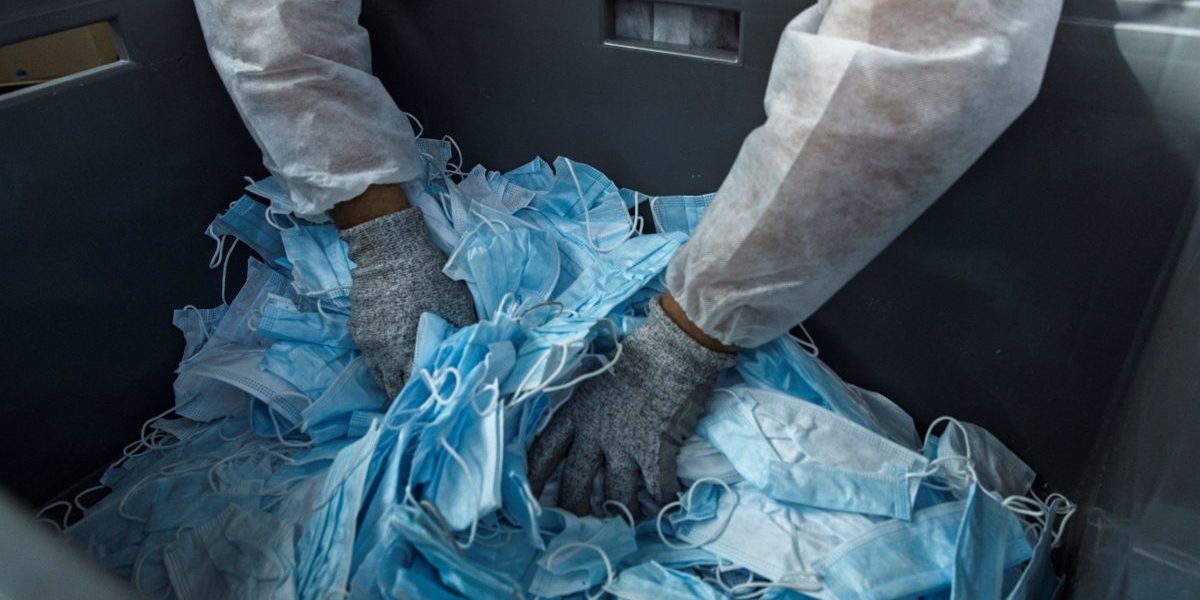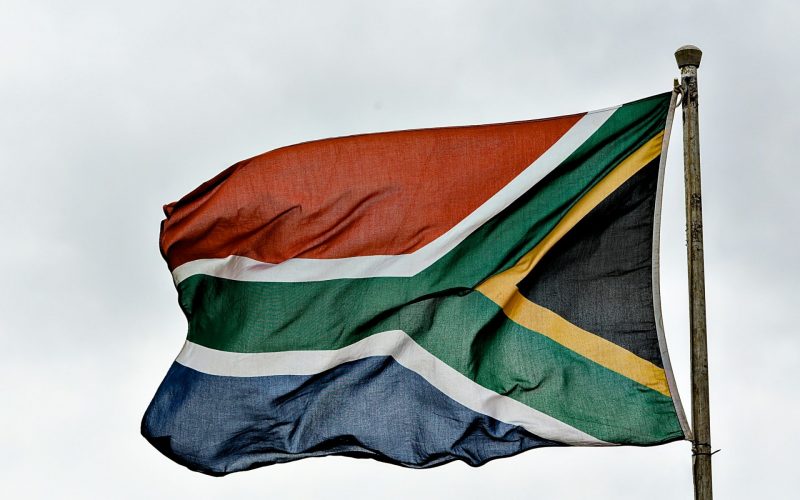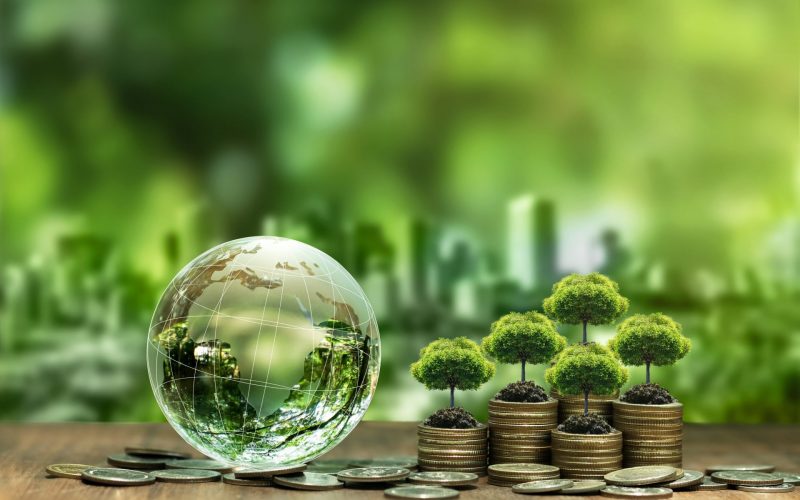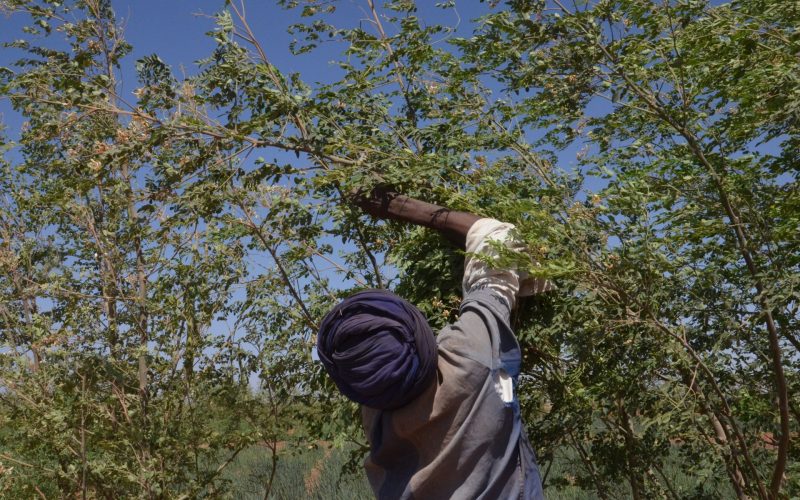Recommendations:
The EU-AU Summit should:
- In light of the COVID pandemic, maintain as much as possible from the Strategy with Africa, especially in its ambition to include Africa in the EU’s green and circular economy.
- Insist that all future programmes and partnerships between the two parties start off from a circular economy approach as a baseline from which to build sustainable economic growth and the eventual attainment of the Sustainable Development Goals.
- Focus on how the EU and African states can shorten critical value chains for mutual benefit, especially for food and medical security.
Executive summary
The circular economy approach to sustainable economic development has in recent years gained traction and is now included in the European Union’s Green Deal committing the EU to becoming carbon neutral by 2050. African countries practice aspects of the circular economy without having specific policies included in their national development plans.
It was expected that the EU and the AU would have met in 2020 for their Annual Summit but the COVID-19 pandemic has forced the two partners to postpone the meeting. The circular economy was to be discussed as part of the EU’s ‘Comprehensive Strategy Towards Africa’.
This policy brief discusses the circular economy within the context of the COVID-19 pandemic and prospects for a green economic recovery for both the EU and the AU. Although the pandemic has had a devastating impact on both partners there are strong arguments that the EU should not loose sight of its carbon neutrality targets and that Africa will do well to also focus on the circular economy for its recovery plans.
Introduction
Europe and Africa have been hit hard by the COVID-19 pandemic and whereas Europe seems to be emerging from the crisis, Africa remains in the throes of increasing infection rates and the slowing down of their economies. On the African continent, nascent industries in regional value chain development are being hit hardest by border closures and decreased global demand. Europe experienced a reality check as to its reliance on global value chains for essential goods and services during the pandemic and wants to use the post-COVID stimulus package to shorten production chains.
On the surface this does not bode well for Africa as the EU remains its largest trading and investment partner. However, redirecting manufacturing inputs and shortning the global value chain is not a zero-sum game, especially if the EU remains committed to the benefits of the circular economy, which it has done both in domestic policy documents as well as in its position on the future of the AU-EU relationship. This policy brief unpacks how this can unfold in a post-COVID crisis world.
The circular economy
The UN Industrial Development Organisation (UNIDO) defines the circular economy as a manufacturing process where ‘products are designed for durability, reuse and recyclability, and materials for new products come from old products. As much as possible, everything is reused, remanufactured, recycled back into a raw material, used as source of energy, or as a last resort, disposed of.’ 1UNIDO, Circular Economy, (Vienna: UNIDO, 2017), https://www.unido.org/sites/default/files/2017-07/Circular_Economy_UNIDO_0.pdf.The image below shows how the four pillars of this economy – reducing our environmental footprint, generating increased income, reducing resource dependency and minimising waste – are connected by a continuous process and is therefore best described as a ‘circular’ economy.
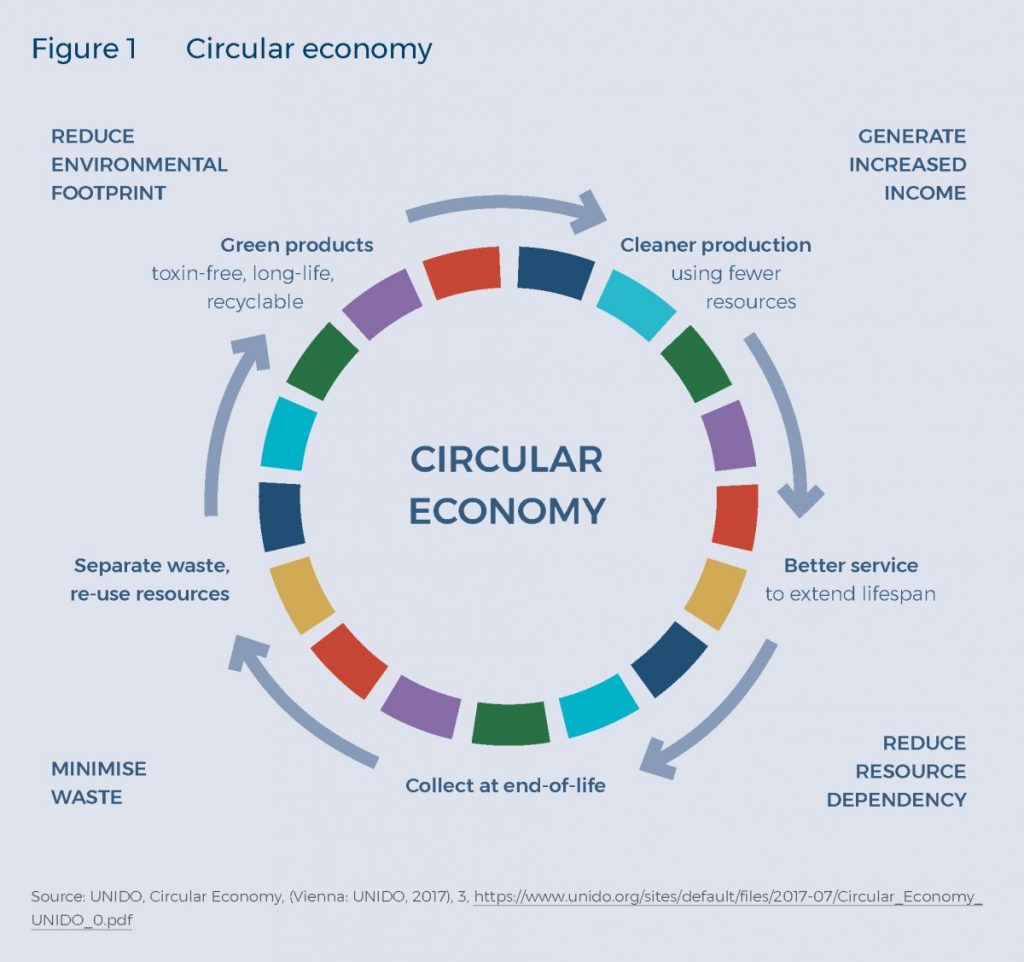
The principle of the circular economy gained traction in 2015 when the UN adopted the Sustainable Development Goals (SDGs), which underpin the idea of enhancing sustainability via reducing resource dependency and waste. Also in 2015, the EU adopted a Circular Economy Action Plan that sets out goals for food, water and plastic reuse.2This Action Plan was updated in 2020, see https://ec.europa.eu/environment/circular-economy/pdf/new_circular_economy_action_plan.pdf.Due to the initial focus on recycling and the link to the SDGs, governments and businesses first perceived the circular approach to be costly. The debate focused on who should carry the cost and responsibility for the end of life management of a product. Whereas some argue that the developer and producer of the product should commit itself to its final end destination, others argue that the user should be responsible for this.
A study done by McKinsey showed that in 2012 the European economy was still staggeringly wasteful, with only 5% of raw materials being recycled and reused. A wasteful economy is not only one that simply produces and then discards in a linear fashion, but is also wasteful during the production process by disregarding the impact on the environment during production and use of the product. The McKinsey study argued that if new technologies were adopted and new production processes focused on sustainability, the European economy could add Euro 1.8 trillion by 2030.3McKinsey & Company, Growth within: A circular economy vision for a competitive Europe, McKinsey & Company, 2015), https://www.mckinsey.com/business-functions/sustainability/our-insights/growth-within-a-circular-economy-vision-for-a-competitive-europe.Since 2015, small, medium and large companies have all shown that there is real economic benefit in the circular economy approach and whereas some inputs and jobs may be lost, new opportunities are created. A follow-up study by McKinsey in 2017 showed that most industries can benefit from six circular economy activities, including:4McKinsey & Company, ‘Mapping the benefits of a circular economy’, McKinsey Quarterly, June 2017, https://www.mckinsey.com/~/media/McKinsey/Business%20Functions/Sustainability/Our%20Insights/Mapping%20the%20benefits%20of%20a%20circular%20economy/Mapping-the-benefits-of-a-circular-economy.pdf.
- renewable energy and materials;
- promoting the sharing of products or otherwise prolonging product life spans through maintenance and design;
- improving product efficiency and removing waste from supply chains;
- keeping components and materials in ‘closed loops’ through manufacturing and recycling;
- delivering goods and services virtually; and
- replacing old materials with advanced renewable ones or applying new technologies such as 3-D printing.
Government’s role in promoting the circular economy
Governments have an important role to play in incentivising a shift to a green and circular economy. In addition to the Circular Economy Action Plan, the most important policy driving the shift in the EU towards a circular economy is the Green Deal, which commits the EU to becoming the first climate-neutral continent by 2050. At its centre is the commitment to the circular economy approach to production. Several directives and milestones are set within the context of the deal, one being the directive to ban all singleuse plastics by 2021.
Despite the fact that official circular economy policies are not in place in most African countries, there is a definite recognition that there is vast potential in Africa for job creation and economic growth, and that the SDGs are attainable if sustainable economic practices are adopted. Many African countries are introducing the concept of a green economy to new policies in a variety of sectors but without an explicit focus on the circular economy. A study released by UN Environment Programme in 2016 that looked at eight African countries implementing green strategies showed that ‘under green economy investment scenarios… national real GDP in Kenya is projected to exceed a business-as-usual model by approximately 12% by 2030. While in the energy sector, investments in expanding solar and wind capacity in Senegal, for instance, are projected to create up to 30,000 additional jobs by 2035.’ 5UN Environment Programme (UNEP), Building Inclusive Green Economies in Africa: Experience and Lessons Learned, 2010-2015, (UNEP, 2015), https://www.greengrowthknowledge.org/sites/default/files/downloads/resource/Building_Inclusive_Green_Economies_In_Africa_UNEP.pdf.And there are several case studies spanning the continent that have picked up on how innovation is being used, either through new ways of using or reusing materials, or using new technology for production purposes that create economic gain within the context of the circular economy for Africa. Through a collaborative process between South Africa, Nigeria and Rwanda, the African Circular Economy Alliance was established in 2017 with the aim to bring experts from both Africa and the EU on the circular economy together to create momentum on the African continent towards adopting policies that would promote circular economy practices.6Peter Desmond and Milcah Asamba, “Accelerating the transition to a circular economy in Africa,” chap. 9 in The Circular Economy and the Global South, London, Routledge, 2019), 152-172, https://www.researchgate.net/publication/332416054_Accelerating_the_transition_to_a_circular_economy_in_Africa.
Has COVID-19 changed everything?
In 2020 the world economy was sent into a tailspin when the World Health Organisation announced on 12 March 2020 that COVID-19 was a global pandemic as infections started to rise in almost every country. Countries closed borders and lockdowns were announced in many cities. Only essential services continued to operate and businesses closed, international trade ceased and uncertainty quickly impacted negatively on international financial markets.
The impact on the EU
The EU has estimated that its community GDP would decline by 6.44% but that there are sharp variations between the various regions and countries. Those that are dependent on tourism for income are harder hit than those economies that are predominantly manufacturing and agriculture based. In April 2020, discussion at the EU Commission centred around concerns that the pandemic has exposed the EU’s over-reliance on global supply chains. While the Commission discussed stimulus packages to assit member states to overcome the negative impacts of the pandemic, some called for the Green Deal targets to be postponed, particularly calling for the directive on single use plastics to be either abandoned or postponed. The reason being the mountain of single-use plastic waste from gloves, to aprons and masks created by the pandemic. Many restaurants, in order to keep business going, shifted to take-out services and reintroduced plastic cutlery and singleuse containers for food. The European Plastics Converters trade association called for the postponement of the single-use plastic ban, but the Commission argued that it is more important in a time of crisis to find the solutions that will accelerate the innovation of products away from single-use plastics rather than to abandon self-set deadlines.7Frédéric Simon, ‘EU dismisses industry calls to lift bn on single-use plastics’, Euractiv, April 15, 2020, https://www.euractiv.com/section/circular-economy/news/eu-dismisses-industry-calls-to-lift-ban-on-single-use-plastics/.
More worrying to the Commission was that the EU’s reliance on international value chains was exposed and that, with trade processes becoming delayed due to closed borders and countries veering towards isolationsism, the EU will have to relook how and from where it sources goods, especially medical and food supplies. The pandemic showed that it was predominantly Asian countries that produced medical gloves and that the entire world was trying to secure access, driving up prices and resulting in conflicts with other regions also trying to secure the same items.
Within this environment it would be easy to lose sight of Green Deal targets and circular economy ambitions, but EU Commission President Ursula van der Leyen has come out strongly stating that ‘investing in large scale renovation, renewables, clean transport, sustainable food and nature restoration will be even more imprtant than before. This is the lesson we need to learn from the crisis.’ 8Ewa Krukowska and Nikos Chrysoloras, ‘Europe Signals Pandemic Made Green Agenda a Security Priority’, Bloomberg Green, April 16, 2020, https://www.bloomberg.com/news/articles/2020-04-16/stimulus-measures-should-help-green-shift-eu-climate-chief-says.In July 2020 the EU announced what is seen as a ‘green recovery deal’ that aims to ‘build back better’ post COVID-19. The recovery deal has a total budget of EUR9Currency code for euros 1.074 trillion ($1,17 trillion) of which EUR 550 billion ($648 billion) is safeguarded for green projects.10Kate Abnett and Matthew Green, ‘EU makes world’s biggest ‘green recovery’ pledge – but will it hit the mark?’, Reuters, July 22, 2020, https://www.reuters.com/article/us-eu-summit-climate-change/eu-makes-worlds-biggest-green-recovery-pledge-but-will-ithit-the-mark-idUSKCN24N231.At the same time, Europe’s future security will depend on how it procures agricultural products and raw materials for its heavy industries. Remaining committed to the circular economy apporach at the time of crisis pushes companies to think more in the direction of what is available immediately within the EU that can be reused and repurposed.
The region is in the fortunate position of being able to afford fiscal stimulus packages that can support households via income subsidies, tax rebates and unemployment benefits. However, the funds also need to be used to invest ‘in the new economy to come out of the crisis in better shape than we went into it, fit for the future: sustainable, inclusve, competitive and prepared.’11EU climate chief Frans Timmermans and Bertrand Piccard quoted in Krukowska, “Europe Signals Pandemic”.The AU should take urgent note of Europe’s intention to become more self-sufficient and reasses how its role in global value chains will be included in such new investments, or are safeguarded in order to protect African livelihoods.
The impact on Africa
Even without significantly large number of infections or deaths – broadly speaking – the economic outfall of the pandemic for the AU has been significant. The International Monetary Fund (IMF) reported that Low-Income Developing Countries (LIDCs), many of which are on the African continent, ‘have been hit by an exceptional confluence of external shocks: a sharp contraction in real exports, lower export prices, especially for oil, less capital and remittances inflows, and reduced tourism receipts.’12Daniel Gurara, Stefania Fabrizio and Johannes Wiegand, ‘COVID-19: Without Help, Low-Income Developing Countries Risk a Lost Decade’, IMF Blog, August 27, 2020, https://blogs.imf.org/2020/08/27/covid-19-without-help-low-income-developing-countries-riska-lost-decade/.Unlike in Europe, emerging economies and LIDCs are not in a position to implement effective fiscal stimulus packages.
The IMF warns that the international community will have to ensure that LIDCs are not forgotten as developed and emerging economies are rebuilding their own economies. It especially warns the developed world against implementing protectionist measures and that critical supply chains in the food and medical industry should be supported and protected in LIDCs, and not be targeted for exclusive use. Other important recommendations include re-evaluating progress towards attaining the SDGs, and extending debt relief and restructuring beyond the G20 Debt Service Suspension Initiative.13Gurara, “COVID-19: Without Help”.
There are two critical areas for Africa to build and rebuild their participation and importance in regional and global value chains. The one is in mining and the other is in agriculture. The fourth industrial revolution is shifting the value of raw materials away from traditionally mined products to new minerals essential for new technologies. African countries have to ensure that beneficiation and deeper participation in production remains on the continent and that fair prices are paid for minerals. In agriculture there is real and immediate potential for African countries to adopt and participate in the principles of the cicular economy by ensuring that stepping up production does not go hand-in-hand with environmental degradation and that new technologies attract educated labour back to rural areas to participate in commercial agricultural enterprises that result in wealth creation for their communities. It is estimated that close to 40% of children under the age of five on the continent are still undernourished. The COVID-19 pandemic is expected to exacerbate this situation. As in Europe, the African Development Bank is advocating for shorter value chains to reduce Africa’s vulnerability to external shocks and to invest in the digitalisation of value chains to harness the benefits of new technologies.14Kevin Urama, “Building Resilience in Food Systems and Agricultural Value Chains in Post COVID-19 Africa” (presentation, African Development Bank Seminar on Building Resilience in Food Systems and Agricultural Value Chains: Agricultural Policy Responses to COVID-19 in Africa, May 18, 2020 Abidjan, https://www.afdb.org/sites/default/files/news_documents/presentation_for_seminarag_policy_-final_-_18-05-2020-2.pdf.These will require strong partnerships between the member states of the AU but also with international partners like the EU.
The EU-AU Summit – finding mutually beneficial solutions for economic recovery
The EU-AU Summit was supposed to take place towards the end of 2020, but as of yet it remains unclear whether or how it can take place. Before the COVID-19 pandemic the European Commission and the European External Action Service presented their joint communication, ‘Towards a comprehensive Strategy with Africa’, to the Foreign Affairs Council and the EU Parliament. The strategy was supported as long as concrete plans were developed on how to implement the strategy with an effective monitoring and evaluation system to track its effectiveness. The circular economy lies at the core of the strategy with the EU proposing five partnerships:
- a partnership for green transition and energy access – this clearly forms part of the four pillars of the circular economy;
- a partnership for digital transformation – this is necessary to make use of the best models to minimise a negative impact on the environment during production, use and disposal of products;
- a partnership for sustainable growth and jobs – this is a critical area of interest for Africa as it needs to create jobs at a rapid rate without losing sight of the SDGs and other climate change mitigation and adaptation commitments;
- a partnership for peace and governance; and
- a partnership for migration and mobility.
The COVID pandemic has derailed the milestones towards the EU-AU Summit, with the EU taking an initial internal view towards recovery and the African continent still dealing with closed borders and infection rates. It is unclear whether the Strategy with Africa can survive in its current form and whether there will be sufficient financial support available to implement the five partnerships. Instead, the AU and the EU could focus on how Africa’s mineral resources and agricultural potential can feed into the EU’s desire to shorten its value chains and improve its food and medical security while remaining committed to its target of carbon neutrality by 2050 and whilst remaining committed to Africa’s continued development.
Conclusion
When the EU-AU Summit finally takes place, both parties need to focus on how the COVID-19 pandemic and resulting economic crisis can be used to elevate their relationship within the spirit of ‘build back better’. Where Europe is correct in wanting to ensure its emergency response and food security by bringing production and value chains closer to home, it could persent a unique opportunity for the African continent to work closely with Europe on Africa’s agricultural strength, bring in new technologies that fit a circular approach to production and at the same time help African countries build the regional value chains that have so long remained elusive on the continent.
Acknowledgement
This policy briefing has been published as part of a series under the project Partnership for a Green Transition and Energy Access: Strategic priorities for Africa and Europe. The project is a partnership between SAIIA and the Konrad Adenauer Stiftung’s Regional Programme on Energy Security and Climate Change in Sub-Saharan Africa.

